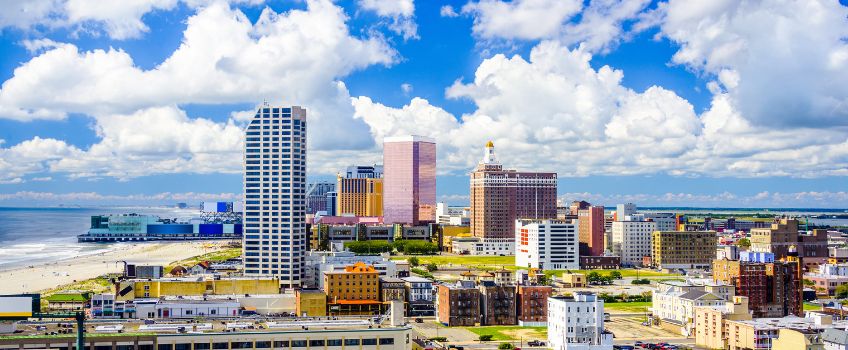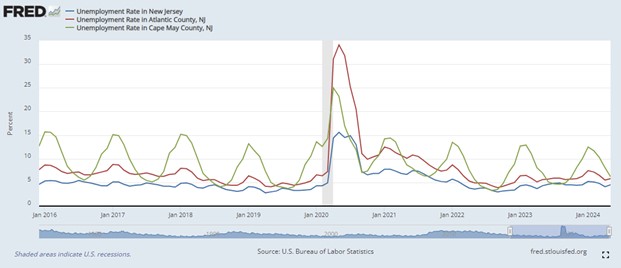Housing Atlantic City
By Sarah Grady, Assistant Director LIGHT - Stockton University
Sarah Grady, MA
Assistant Director LIGHT, Stockton University
Atlantic City’s history and identity as a resort destination go back long before the arrival of casinos in 1978. It is a community every bit as diverse and vibrant as its larger neighbors Philadelphia, New York and Newark.
Like many urban communities, Atlantic City struggles with more- and less-visible challenges that ultimately link back to a cycle of poverty that has proven difficult to break. Community leaders are all too aware of the many and varied forces that impact their efforts to appeal to seasonal visitors and improve quality of life for year-round residents.
One facet of this highly complex gem is housing. Numerous reports over the years have captured a picture of housing resources that are aging, and by some measures, not "affordable" for residents.
Aging Housing Units, Renting vs. Home Ownership
According to the 2022 American Community Survey from the U.S. Census Bureau, Atlantic City has 20,641 total housing units of which 72% were built before 1980. For comparison, 66% of Newark, New Jersey’s 121,773 housing units were built before 1980.
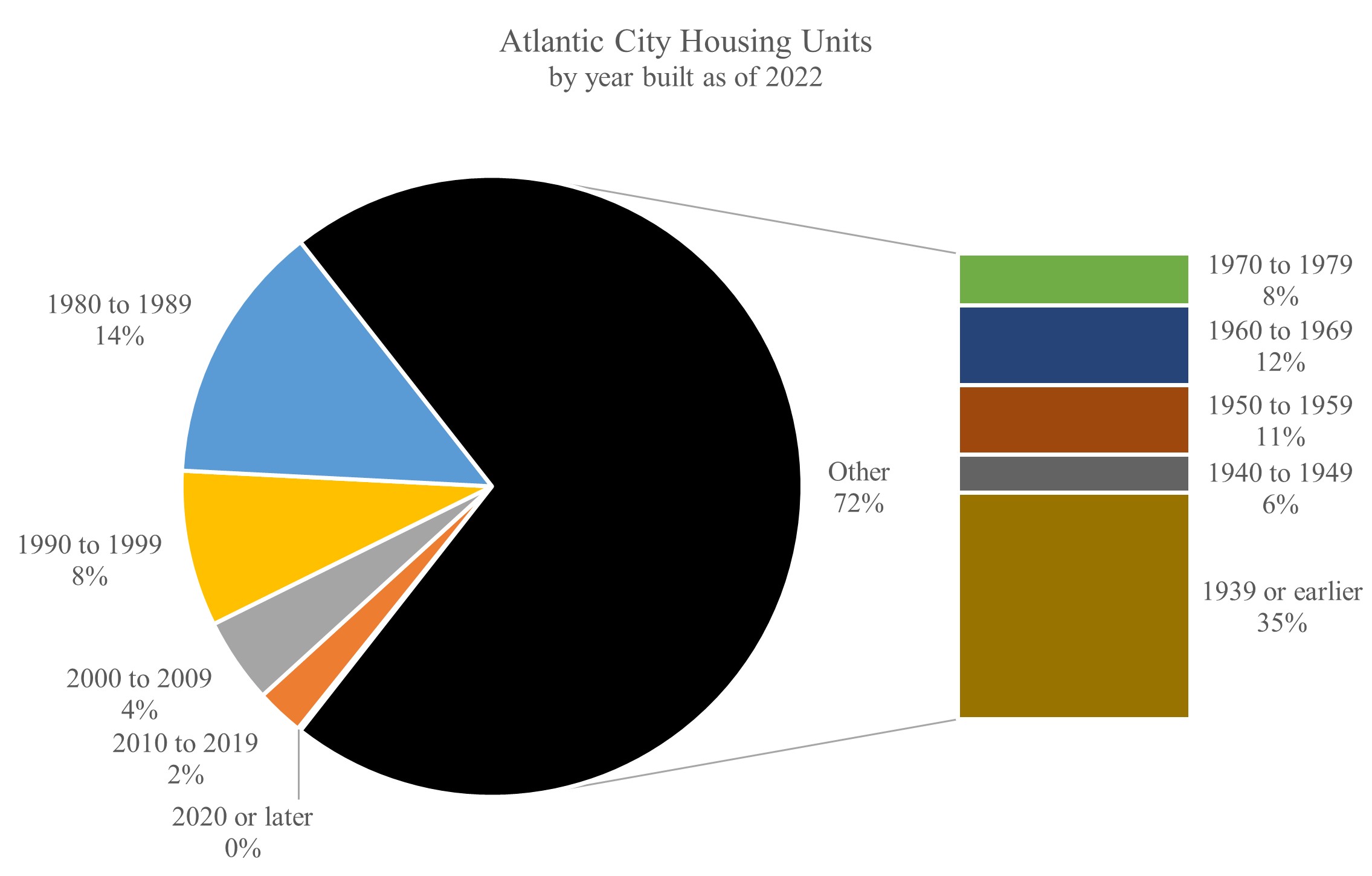
Age is not necessarily an indicator of the condition or quality of housing as units of any age may be more or less well constructed and maintained. However, housing in Atlantic City is still struggling in comparison to its urban peers. According to data from the U.S. Census Bureau, 0.8% (124) of occupied housing units in the city lack complete plumbing facilities and 2.2% (358) lack complete kitchen facilities. This is nearly twice the rate of Newark 0.4% and 1.3% respectively.
79.8% (16,473) of Atlantic City’s housing units are occupied, the majority (69.2%) by renters who pay a median monthly rent of $1,057. Residents who own their homes pay a median $1,790 with a mortgage and $920 without a mortgage per month in housing expenses.
Again, for comparison, 92.5% (112,635) of Newark’s housing units were occupied, with 76.1% of these occupied by renters who pay a median rent of $1,273. Homeowners in that city pay a median $2,413 with, and $1,044 without a mortgage monthly for their housing.
Affordability
The U.S. Department of Housing and Urban Development (HUD) defines affordable housing as “housing for which the occupant(s) is/are paying no more than 30 percent of his or her income for gross housing costs, including utilities.” By that definition, over 60% of Atlantic City’s renters are not paying affordable rents.
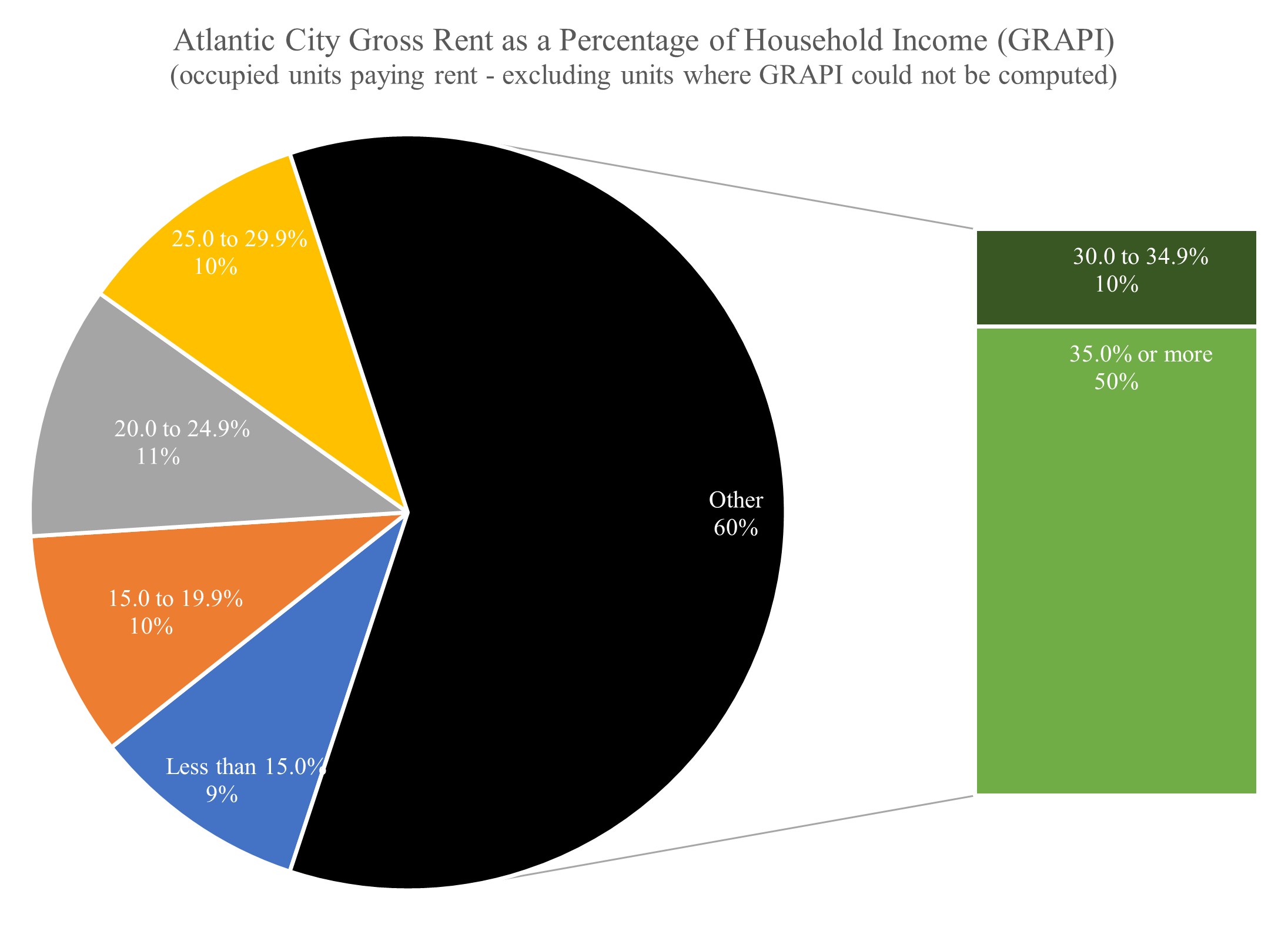
This is not unique to Atlantic City. Newark’s renters are experiencing similar challenges with 54% spending 30% or more of their household income on housing.
For Atlantic City’s median rent of $1,057 to be "affordable," the renter’s household would need a monthly income of approximately $3,523 or an annual income of $42,276. According to the U.S. Census Bureau (Census), as of 2022 median household income for the city (including households that do not rent) was $35,188.
Wages
Employment and wages play a significant role in overall household income and the affordability of housing. According to the May 2022 Occupational Employment Statistics report from the U.S. Bureau of Labor Statistics, annual wages for gaming, hospitality and tourism workers in the Atlantic City-Hammonton Metropolitan Statistical Area were often higher than median individual earnings for the city and in the case of industry supervisors higher than the median wage for full-time, year-round workers.
The annual (untipped) mean wage for food preparation workers in the Atlantic City-Hammonton Metropolitan Statistical area was $31,870 and for maids and housekeeping cleaners it was $32,040. Gambling dealers could expect more at $49,150 (untipped) on average for the year. Industry supervisors, such as for food service ($45,290), housekeeping ($46,130) and gambling ($65,640), received even higher wages. Wages high enough to afford more than median rent with a single income.
Employment, Unemployment and Homelessness
According to the 2022 American Community Survey from the U.S. Census Bureau, 36.8% (5,686 of Atlantic City’s civilian employed population 16 years and over (15,456) were employed in arts, entertainment and recreation, and accommodation and food services industries. Gaming, hospitality and tourism are significant drivers of employment in the city, and the casinos are some of the city’s largest employers.
Like many resort destinations that rely heavily on such businesses, Atlantic City’s employment levels fluctuate along with the tourism season with the lowest monthly unemployment rates seen at peak summer and the highest in the dead of winter. Business operators hire seasonal workers proportionate to consumer demand. When customer demand ebbs in the offseason, these positions are dissolved. While some of these seasonal positions are filled by youth and nonresident workers, some are filled by year-round city residents. The seasonal cycle of work availability can lead to cycles of unemployment for some of these residents.
This graph from the Federal Reserve Bank of St. Louis (FRED), shows the cycle of seasonal unemployment in Atlantic County with Cape May County
and the state of New Jersey included for comparison. A subtle seasonal pattern can
be seen in Atlantic County unemployment. In 2016, 2017 and 2018 unemployment peaked
between 8.3% and 8.7% in January and valleyed between 5-7% in August. The opening
of the Hard Rock and Ocean casinos in Atlantic City in June 2018 disrupted this cycle
and lowered unemployment overall. In January 2019 and 2020, Atlantic County unemployment
peaked at 6.7% and 6.8%, respectively, and in 2018 and 2019, unemployment valleyed
at 4.5% (November 2018) and 4.2% (May 2019).
The pandemic upset this cycle and Atlantic County unemployment peaked at 34.4% in June 2020, recovered to 10.1% when casinos reopened in July and ebbed into the winter to 12.5% January 2021. As of May 2024, the cycle of seasonal unemployment in Atlantic County had reasserted itself peaking at 7.5% in January 2024 and valleying at 5.5% in April 2024 ahead of the summer tourism season.
When steady employment isn’t a given, housing costs, especially when they are 30% or more of a household’s income, become more difficult to manage. The loss of one or more incomes in a household for any significant period can quickly make even affordable rent unaffordable. Depending on a household’s debt or savings circumstances, there may or may not be a financial cushion to absorb even short-term losses of income. Without intervention, this, along with various other circumstances, can lead to cycles of housing instability and homelessness.
On January 24, 2022, Monarch Housing Associates counted a total of 343 homeless persons in Atlantic County. Most of these individuals (291) were counted in Atlantic City, including 93 individuals who were recorded as being unsheltered. While a small fraction of the estimated 38,487 individuals residing in the city in 2022, the sheltered and unsheltered homeless population in Atlantic City has been the focus of numerous outreach efforts from dedicated nonprofit groups like the Atlantic City Rescue Mission, Covenant House and Jewish Family Service of Atlantic County. Their efforts and the collaborative efforts of other stakeholders like the Boardwalk Improvement Group (BIG) have done much to address homelessness, however it is a multifaceted issue without a straightforward solution.
Quality of Life
The challenge of addressing housing instability and providing better housing options is not a simple one. Even if all new, low-rent housing was built, and more Atlantic City residents were employed in full-time, year-round jobs paying higher wages, the city would still need to address quality of life issues that lead some Atlantic City workers to choose living accommodations outside of the city.
Quality-of-life projects, such as improving the appearance of public spaces, managing city traffic and transportation, and adding to community amenities like parks and bike routes, have the added benefit of appealing to seasonal visitors and potential second and retirement homeowners.
Efforts to improve quality of life in Atlantic City may already be contributing to greater demand for housing in the metropolitan area. As reported by the National Association of Realtors, median home prices in the Atlantic City – Hammonton metropolitan area have increased in recent years and, as of first quarter 2024, the current level of construction (as measured by the number of 1-unit building permits issued) was 18.6% above the long-term average.
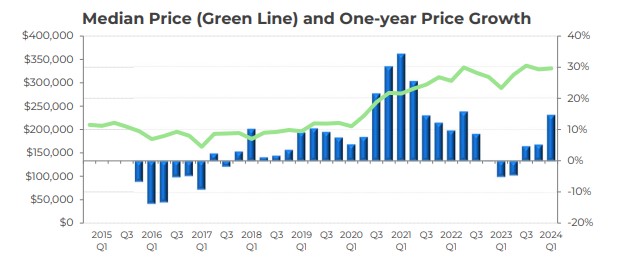
Source: National Association of Realtors
If the city becomes increasingly attractive to individuals looking for primary homes, second homes and even homes in retirement, we may see unoccupied or aging housing units redeveloped to meet demand. This will not only address the aging of Atlantic City’s housing stock, but also reduce the blight associated with vacant housing units.
Developers are taking an interest in Atlantic City.
Here are a few housing projects that have been in the news:
Knights of Columbus Building
A developer is working to secure funding to redevelop the historic building located on Pacific Avenue at St. James Place as 'workforce housing.'
Bader Field
Atlantic City Mayor Marty Small Jr. has acknowledged some frustration with being unable as of yet to finalize plans for a $3.2 billion development by DEEM Enterprises at Bader Field.
Morris Guards Armory
The 122-year-old former Morris Guards Armory at 10 S. New York Ave is being redeveloped as apartments.
Lighthouse Row
An Atlantic City resident is developing eight new residential homes for four townhome buildings in the Southeast Inlet.
Conclusions
The challenges and opportunities for Atlantic City, specifically around housing, are well known. Housing has been included in countless public conversations and reports as one of several key initiatives necessary to improve the city’s prospects in the long term.
These conversations have resulted in the allocation of public funds and the commitment of community partners to quality-of-life projects like bringing a grocery store into the community and expanding medical facilities for mothers and babies. While the city continues to struggle with securing a grocery store, in November of 2022 AtlantiCare held a ceremonial ribbon cutting for its new $38 million Medical Arts Pavilion on Ohio Avenue in Atlantic City. The pavilion, which allowed AtlantiCare to expand its Maternal Fetal Medicine, Family Planning and Safe Beginnings programs, is increasing access to care and addressing health care disparities like maternal/fetal mortality.
The city is making progress toward improving living conditions for Atlantic City residents. This progress may be subtle, but as long as there is progress there is real hope for lasting change in Atlantic City.
We know that Atlantic City and its residents have potential. We know that the city has access to countless natural and cultural resources. We know that there are people and organizations dedicated to seeing progress in the city. We can leverage this knowledge to advocate for the city, to highlight its potential and encourage outside investment in its future. No single effort will bring about the change that is needed, but together city stakeholders can improve housing for current residents and encourage others to call Atlantic City home.
References:
AtlantiCare. (n.d.). AtlantiCare unveils new Medical Arts Pavilion in Atlantic City. Retrieved July 23, 2024, from atlanticare.org/news: https://www.atlanticare.org/news/atlanticare-unveils-new-medical-arts-pavilion-in-atlantic-city
Federal Reserve Bank of St. Louis (FRED). (n.d.). FRED Graph - Unemployment Rate. Retrieved July 23, 2024, from fred.stlouisfed.org: https://fred.stlouisfed.org/graph/?g=Ard7#0
Monarch Housing Associates. (n.d.). Atlantic County PIT Report. Retrieved July 23, 2024, from monarchhousing.org: https://monarchhousing.org/wp-content/uploads/2022/10/Atlantic-County-PIT-2022-Report.pdf
National Association of Realtors. (n.d.). Atlantic City-Hammonton Area Local Market Report, First Quarter 2024. Retrieved July 23, 2024, from cdn.nar.realtor: https://cdn.nar.realtor/sites/default/files/documents/2024-q1-local-market-reports-nj-atlantic-city-06-05-2024.pdf?_gl=1*gl8tr9*_gcl_au*ODEwMDc0ODcwLjE3MjE3NTU5NDM
U.S. Bureau of Labor Statistics. (n.d.). May 2022 Metropolitan and Nonmetropolitan Area Occupational Employment and Wage Estimates Atlantic City-Hammonton, NJ. Retrieved July 23, 2024, from bls.gov: https://www.bls.gov/oes/2022/may/oes_12100.htm
U.S. Department of Housing and Urban Development. (n.d.). Resources. Retrieved July 23, 2024, from HUD.GOV: https://archives.huduser.gov/portal/glossary/glossary_a.html
United States Census Bureau. (n.d.). Profile: Atlantic City, New Jersey. Retrieved July 23, 2024, from United Sates Census Bureau: https://data.census.gov/profile/Atlantic_City_city,_New_Jersey?g=160XX00US3402080
United States Census Bureau. (n.d.). Selected Economic Characteristics - Atlantic City, New Jersey. Retrieved July 23, 2024, from data.census.gov: https://data.census.gov/table/ACSDP5Y2022.DP03?t=Industry:Occupation&g=060XX00US3400102080&y=2022&moe=false
United States Census Bureau. (n.d.). Selected Housing Characteristics: Atlantic City New Jersey. Retrieved June 13, 2024, from data.census.gov: https://data.census.gov/all?q=Atlantic%20City,%20NJ
United States Census Bureau. (n.d.). Selected Housing Characteristics: Newark, New Jersey. Retrieved June 13, 2024, from data.census.gov: https://data.census.gov/table/ACSDP5Y2022.DP04?t=Housing&g=160XX00US3451000&hidePreview=false

